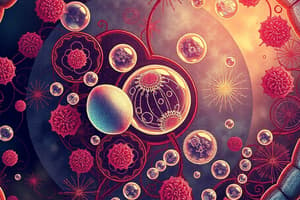Podcast
Questions and Answers
ما هو الغرض الرئيسي من الغشاء البلازمي?
ما هو الغرض الرئيسي من الغشاء البلازمي?
- لإعاقة نمو الخلايا
- لperforming التخليق
- لخزن الماء والسماد
- لتنظيم حركة المواد داخل وخارج الخلية (correct)
ما هو دور الفجوات في الخلية?
ما هو دور الفجوات في الخلية?
- لخزن الماء والسماد والنفايات (correct)
- لإنتاج البروتينات
- لإعاقة نمو الخلايا
- لتنظيم حركة المواد داخل وخارج الخلية
ما هو المكون الرئيسي للغشاء البلازمي؟
ما هو المكون الرئيسي للغشاء البلازمي؟
- مبيدات ليبيد
- مبيدات كربوهيدرات
- مبيدات فوسفوليبيد (correct)
- بروتينات
ما هو العملية التي تنطوي على انقسام الخلية إلى خليتين ابنتين؟
ما هو العملية التي تنطوي على انقسام الخلية إلى خليتين ابنتين؟
ما هو دور دراسة تركيب الخلية؟
ما هو دور دراسة تركيب الخلية؟
Flashcards are hidden until you start studying
Study Notes
Cell Structure
Cells are the fundamental units of life, responsible for carrying out the functions necessary for an organism to survive. They are complex structures composed of various organelles, macromolecules, and other essential components. Understanding cell structure is crucial for comprehending the functions of cells and their interactions within organisms.
Cell Organelles
Cells contain various organelles, which are specialized substructures that perform specific functions. Some of the main organelles include:
- Nucleus: The control center of the cell, containing the genetic material (DNA) and regulating cell activities.
- Mitochondria: The powerhouse of the cell, responsible for producing ATP (adenosine triphosphate), the primary energy source.
- Ribosomes: Structures where protein synthesis occurs through the translation of messenger RNA (mRNA) into amino acids.
- Endoplasmic reticulum (ER): A network of tubules involved in protein synthesis, lipid synthesis, and calcium storage.
- Golgi apparatus: A modifying and sorting center for proteins and lipids, preparing them for transport to their destinations.
- Lysosomes: Membrane-bound organelles containing hydrolytic enzymes that break down cellular waste and foreign substances.
- Peroxisomes: Organelles involved in the breakdown of fatty acids and the detoxification of harmful substances.
- Vacuoles: Membrane-bound structures that store water, nutrients, and waste, as well as perform various cellular functions.
Cell Membrane
The cell membrane, also known as the plasma membrane, is a selectively permeable barrier that surrounds the cell. It regulates the movement of substances in and out of the cell by controlling the size, shape, and charge of molecules. The cell membrane is primarily composed of a phospholipid bilayer with embedded proteins, which create a barrier while allowing for specific molecules to pass through.
Cell Cycle
The cell cycle is the process of cell growth and division, resulting in the formation of two daughter cells. It consists of four main phases: interphase (G1, S, and G2), mitosis (M), and cell division (M). During interphase, the cell grows, replicates its DNA, and prepares for division. In mitosis, the cell undergoes a series of structural changes to create two identical sets of chromosomes. Finally, during cell division, the chromosomes are separated and distributed to the two daughter cells.
Conclusion
Understanding cell structure is essential for comprehending the functions of cells and their interactions within organisms. By studying the organelles, membrane, and cell cycle, we can gain insights into the complex processes that occur within cells, ultimately contributing to our overall understanding of life.
Studying That Suits You
Use AI to generate personalized quizzes and flashcards to suit your learning preferences.




